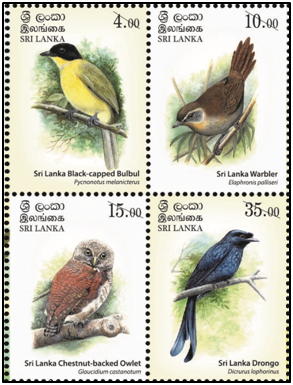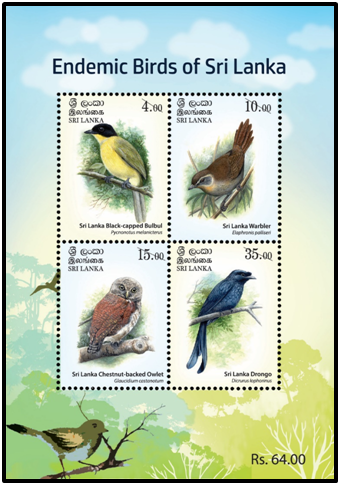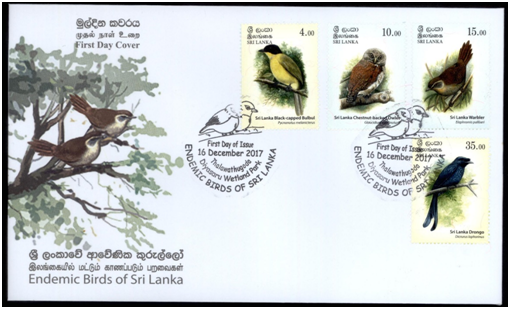

Home/Active Page

Sri Lanka Philatelic Bureau of the Department of Posts has issued a set of Stamps depicting Endemic Birds of Sri Lanka in the denominations of Rs.10.00, Rs.15.00, Rs.25.00 and Rs.35.00 on16th December 2017.
| Date of Issue | 16th December 2017 |
| Denomination | Rs.4.00, Rs.10.00, Rs.15.00, Rs.35.00 |
| Catalogue No: | Rs.4.00:CSL2265 |
| Stamp Designer | Mr.KalumGunasekara |
Stamp Size: | 30mm x 41mm |
| Sheet Composition: | 20 stamps per sheet |

Pycnonotusmelanicterus (Gmelin, 1789)
l¿ bieisfldKavhd, 18-19 cm. Yellowish green above. Yellow below. Black head. No crest. Tail brownish ending in whitetip. Irides, red eyes in male, brown in female
Habit: A very shy bird, calling softly from feedingtrees. Generally seen as pairs except in feeding trees.
Voice: (RA)- Has a number of different songand calls. “Song- cherlmlt-cherlcit/CHINK\U T/CH INK\U T; series of short, mellow, quavering, almostbarbet-like rising then falling notes pwwit, puwit, puwit/wit/wit; a quavering, gradually rising mellowjowu-10w’u-pu ’w/WI Tl; series of subdued, slightly guttural, urgent prrt, prrt, yorrt notes”. (H)- Its call-note is a plaintive, minor-key Whistle on an ascending scale, something like yer, yer ye, or werwerwewe each syllable higher than the last. (HA)- A rising yoryeryee and werwerweewee.
Breeding:Between March-April and again in August-September. l\lest- open, small cup in a fork of a branchwith fibers and small twigs. Clutch 2. Eggs rose—white with numerous brownish spots, measuring21x16 mm.
Habitat: Forest, wooded~areas, gardens.
Distribution: All zones. More plentiful in DZriverine habitats.
Status: Endemic. (N) LC / (G) LC. Common. BrR. List 1.
Sri Lanka Warbler (Sri Lanka Bush-warbler)
Elaphromispalliseri (Blyth, 1851) A
15-16 cm; 9-14 g. Dark, almost blackish above. Pale grey supercilium Eye-ring, throat light buff.
Underparts: yellowish grey. Belly yellowish. Irides, male - red, female- buff. Young male, irides
pale reddish buff. Young female, irides white.
Habit: A very secretive bird moving among theunder growth.
Voice: (RA)- Song- a short, rather musical, slightly squeaky, jaunty outbursttaCH I Kat/WEE, ta/WEE; call - a rich, rather chat-like, abrupt, short, shrill single note squeet. (H)-Sharp alarm-note which is well likened by Legge to the Word quttze though sometimes it soundsmore like quee/~c. (HA)- A squeaky song from an exposed stem and a hard, metallic ohmic call.
Breeding: Between February to Mayand again in September. l\lest~ open, a cup shaped dense,deep nest of fibers and litter, padded with mosses, close to the ground in the under growth.Clutch 2. Eggs whitish-rose with one or two fine long dark brown streaks on the broad side anddar1< purple patches in the rest, measuring 23x17 mm.
Habitat: Confined to vicinity of forestedareas with dense under growth.
Distribution: HZ.
Status: Endemic."(l\l) / (G) NT. Rare. BrR.List 1. ’
Sri Lanka Chestnut-backed Owlet
Glaucidiumcastanonotum (Blyth, 1846)
19cm. Upperparts reddish-brown closely barred with brownish-buff. Underparts, chin, moustachial
streak, middle of breast and abdomen white. Rest barred dark yellowish-green, brown and white.
In flight: Brownish-red patch on underwing.
Habit: Calls in the evenings and morning as the feedin to the early hours of the day.
Voice: (RA)- A loud, resonant, barbet-like, musical, vibrato series ofpurr, PURR, BURRR-BURRR... (HA)- A rising, trilling 0000, 0000, 0000... (H)- Similar to Jungle-owlet. The kraw call of the Jungle.OWlet is uttered in descending scale, wheareas the Chestnut~backedowlets lcrrew is on a kevel scale and somewhat slower.
Breeding: Between March-May. l\lest- closed,in a tree cavity no nest material. Clutch 2. Eggs white, measuring 35x28 mm.
Habitat: Forest, scrub,cultivation.
Distribution: LCWZ and HZ.
Status: Endemic. (L).VU / (G) NT. Uncommon. BrR. Near- threatened species. List 1.
Sri Lanka Drongo (Sri Lanka Crested Drongo)
DicruruslophorinusVieillot, 1817
30cm. Similar to the Raquet~tailedDrongo, but has a characteristic shor and rounded nasal crest.
The tail is also more deeply forked and lacks the prominant ‘raquets’ seen” in the former species.
Plumage glossy black. Often a member of feeding flocks. Very noisy.
Habit: A regular member ofthe mixed speeies feeding flocks of the wet zone. Show ”kleptoparasitism" (grabing food from otherspecies.
Voice: Songs rapidly alternating jangling, clear, silvery, musical notes; (nyit),CH Ll/WlT\CH LI..., (nyit); calls include nasal, mechanical pealing urDLE/BEE”. (HA) - Loud, fruity,often bell-like Whistles and ratchet-like chucks Noisy.
Breeding: Between January-May. Nest- openvery shallow cup attached to the upper surface of a branch made withfibers and covered withlichens. The nest is almost invisible when the bird sits to incubate. Clutch 2-4. Eggs White or rosecoloured with Grey-purple and reddish rose streaks, measuring 27x21 mm.
Habitat: Forest.
Distribution: Wet zone. Confined to forests.
Status: Endemic. (N) VU / (G) LC. Common. BrR. List

All rights received. All right to identify the Department of Posts as the Author and designer of this Bulleting has been asserted in accordance with the Copyright, Design and Patents Act 1988.No part to this publication may be reproduced, stored in or introduced into a retrieval system, or transmitted in any form or by and means (electronic, mechanical, photocopying, recording or otherwise) without the prior permission from the publisher. Any person who does and unauthorized act in relation to this publication may be liable to criminal prosecution and civil claims for damages.